The Intex Challenger K1 is one of the cheapest inflatable kayaks. It even comes in a complete set, so that nothing stands in the way of an immediate paddling tour. We now wanted to know for ourselves how is it to paddle the Intex 1-person kayak and can it compete with a good quality inflatable kayak.
This inflatable kayak is also available as 2-person model. Make sure to check out our review on the Intex Challenger K2 as well, if you are interested in paddling with someone else together. We have also a complete guide about Intex boats and kayaks.
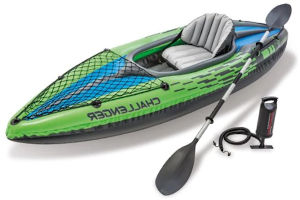
Technical Specs
Max. paddlers:
Length:
Width:
Capacity:
Packed size:
1
274 cm | 9′
76 cm | 2’5”
159 kg | 8.4 lbs
59 x 22 x 42 cm |
1’9” x 7” x 1’4”
Material:
Weight:
Pressure
Produced in:
PVC
12 kg | 26.5 lbs
0,069 bar | 1 PSI
China
Which model has been reviewed?
Intex Challenger K1 from 2019
How did we organize the review?
We have purchased the Intex Challenger K1 ourselves.
How intensively has the product been tested?
low
2 bars = min. 1 day/ 2 half-day tours
3 bars = min. 4 tours
4 bars = min. 8 tours
5 bars = min. 12 tours (very intense)
Where have we tested the product?
Whitewater
Calm rivers
Lakes
First impressions and assembly
The Intex Challenger K1 comes in a compact and very light carrying bag. Since the boat weighs only 28.4 lb, it can be carried comfortably over short distances with the included carrying bag. But the carrying bag is not robust. The material of the bag is so thin that already after the first use there was a small hole in the bottom.
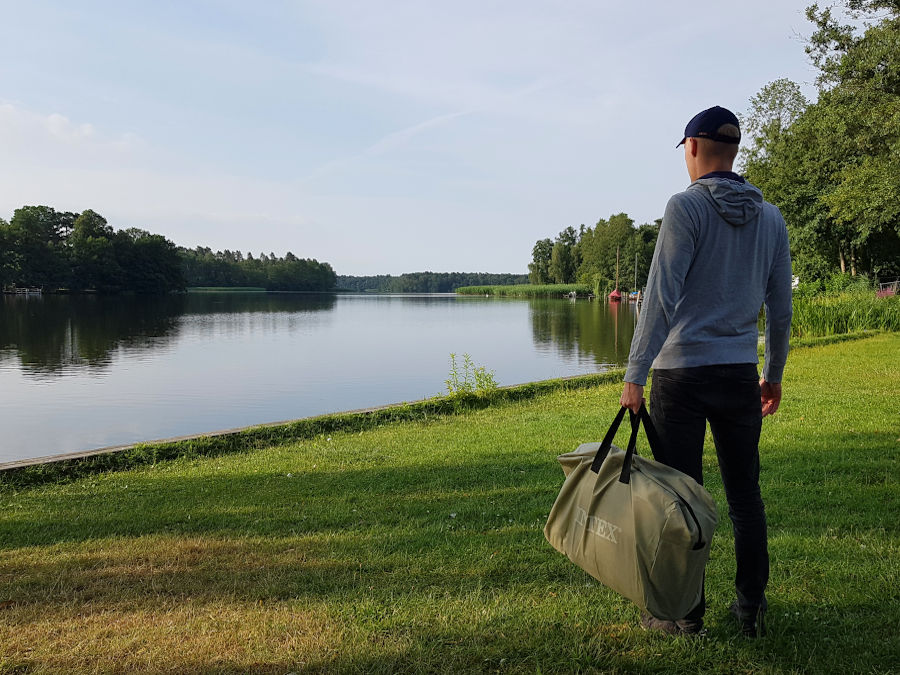
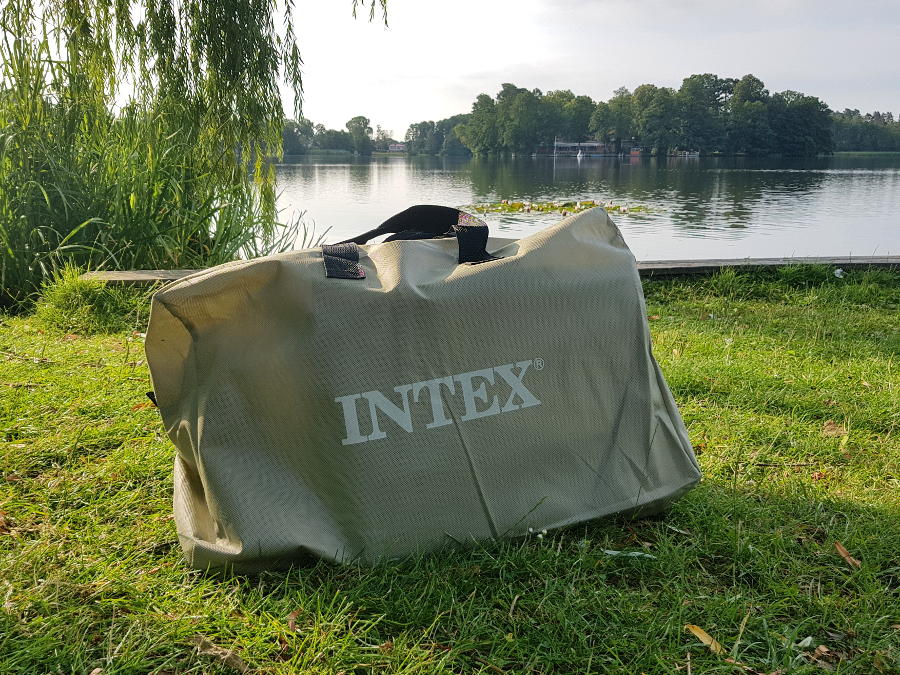
The inflatable kayak is quickly unpacked and amazingly handy. To inflate the kayak you need to unfold it. The Intex Challenger K1 has two separate air chambers, a bottom chamber and a side chamber, each inflated by a Boston valve. Boston valves are 2-way screw valves that allow a quick and safe air inflation and deflation. Due to the separate air chambers it is still possible to reach the shore safely even if one chamber fails.
The bottom chamber is inflated at first with the supplied air pump. Inflating is very easy and goes relatively quickly. Nevertheless, many strokes with the air pump are necessary, because the pump is quite small. Fortunately the kayak is not too big. After inflating the bottom, the second chamber needs to be filled with air, which forms the sides and the deck of the kayak.
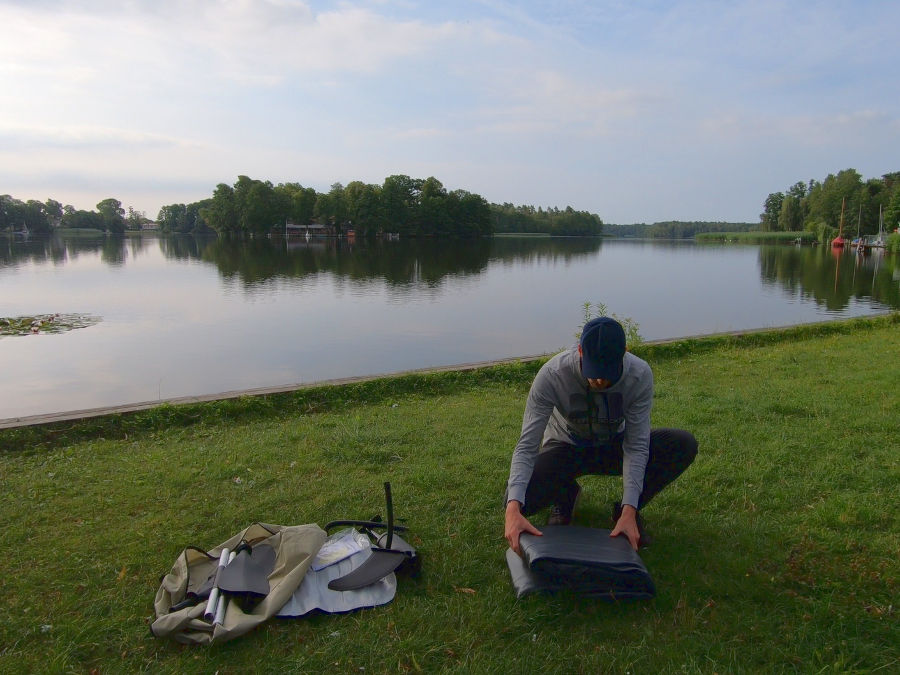
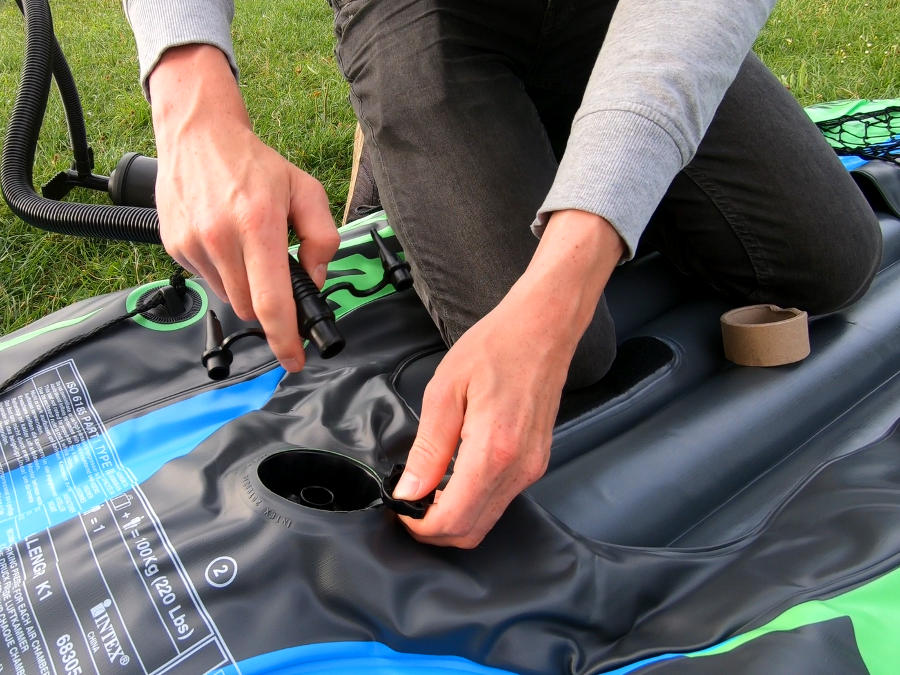
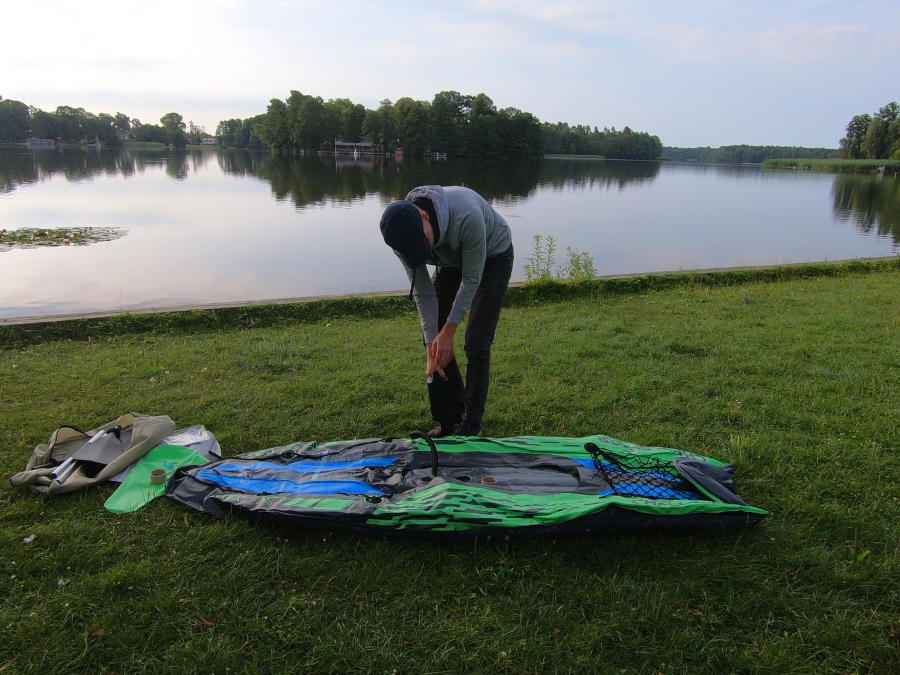
After inflating the two air chambers, the boat has reached its final shape. The interior does not seem very large. There is a hook-and-loop fastener on the floor, which is intended for fixing the seat.
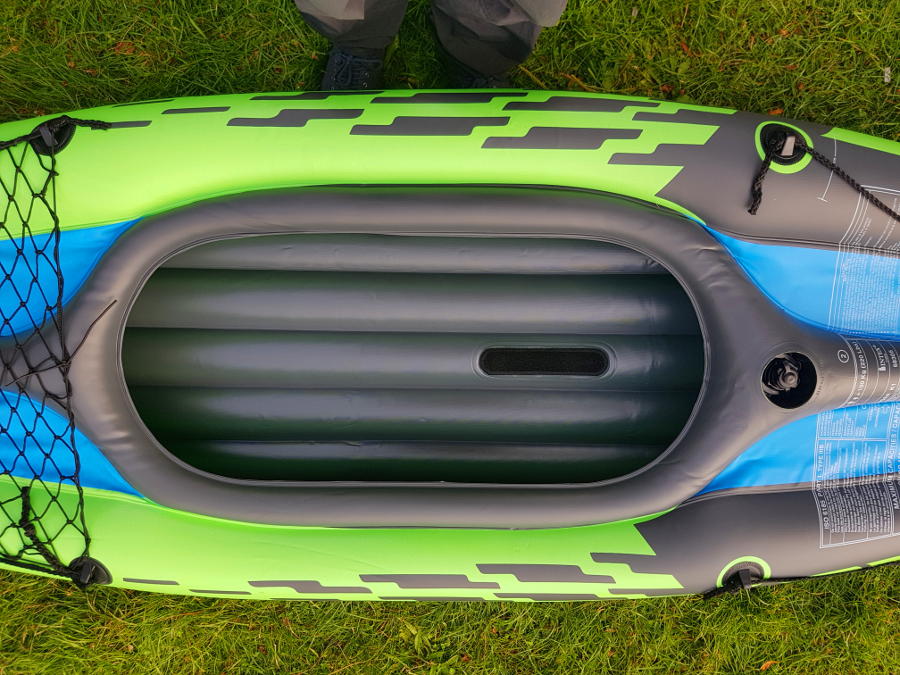
If you are not sure when the correct air pressure is reached, you can measure it. Intex has printed a measuring scale on each chamber for this purpose. With the enclosed measuring strip, it can be checked whether there is enough air in the air chambers or whether one of them still needs to be pumped up.
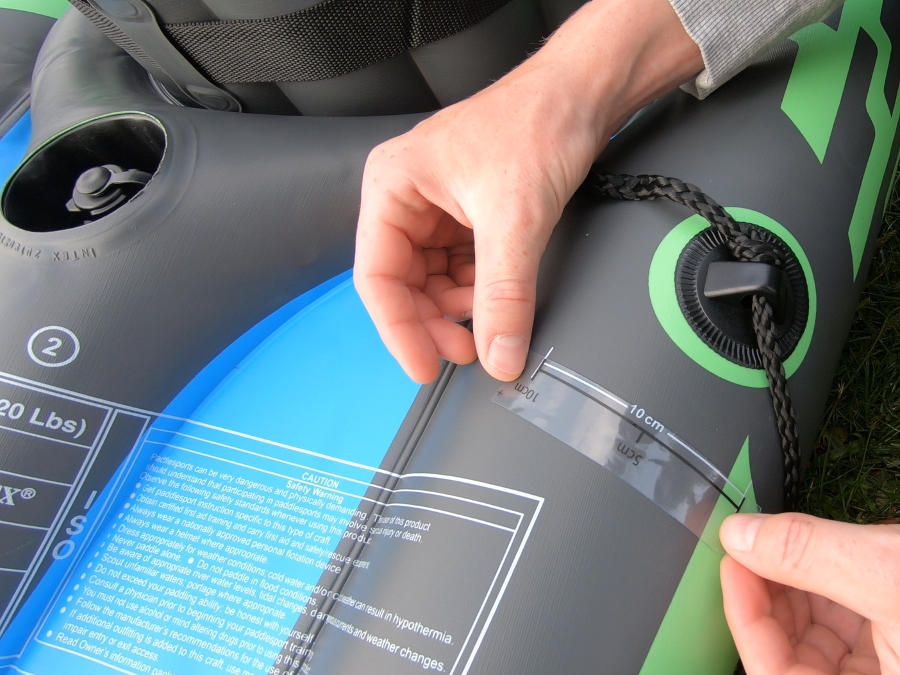
The seat can also be inflated with the air pump. This consists of an inflatable seat cushion and a backrest. The backrest is attached to the side walls with straps and can be adjusted as desired. The seat is slightly wide and bulky for the small interior of the boat. Instead, the seat sits firmly in the boat as soon as it is properly placed in the interior. The fastening of the seat with Velcro is a simple and good idea of the manufacturer.
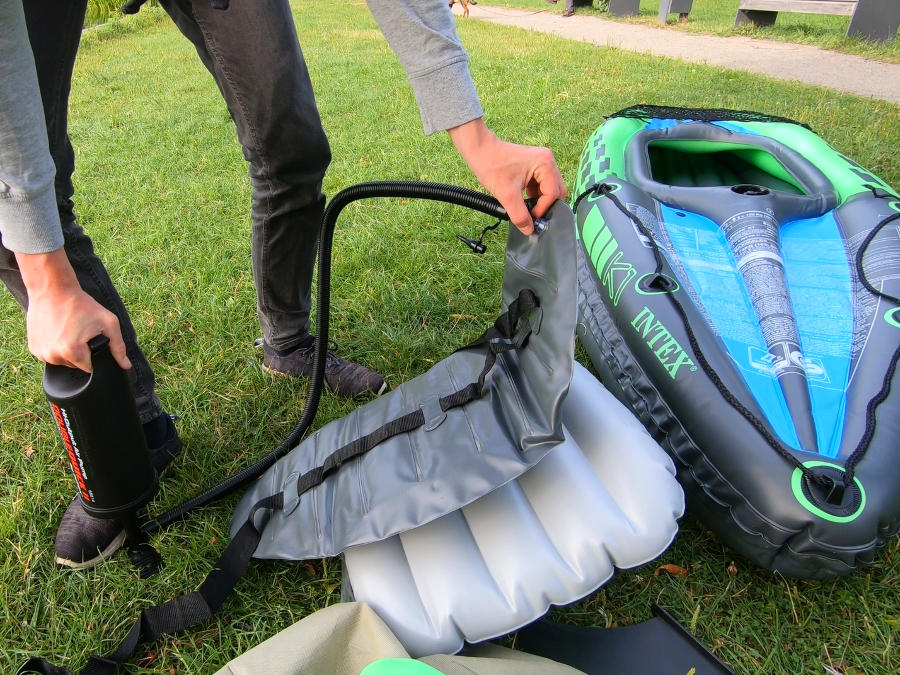
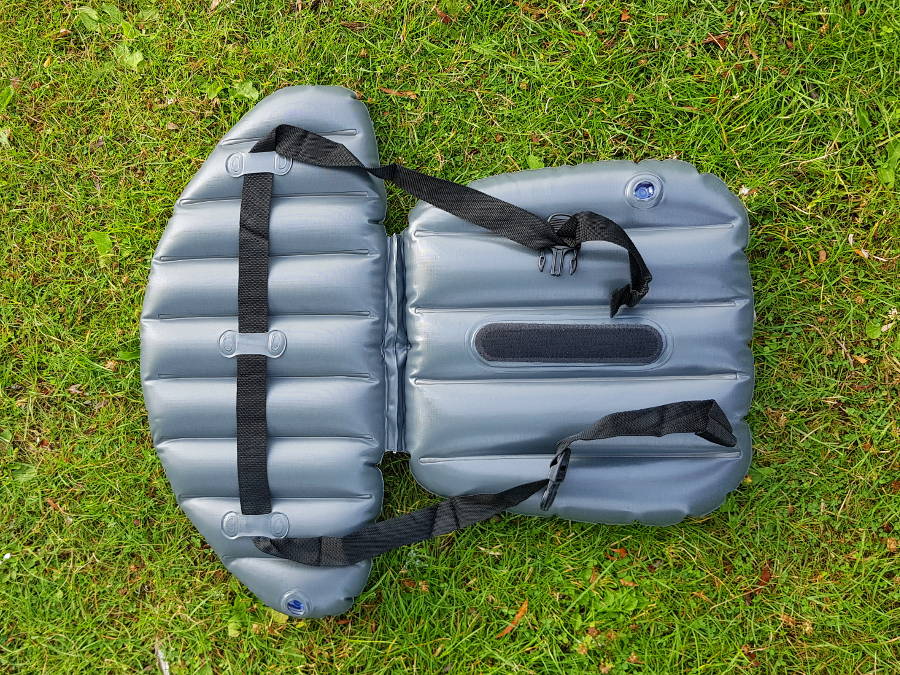
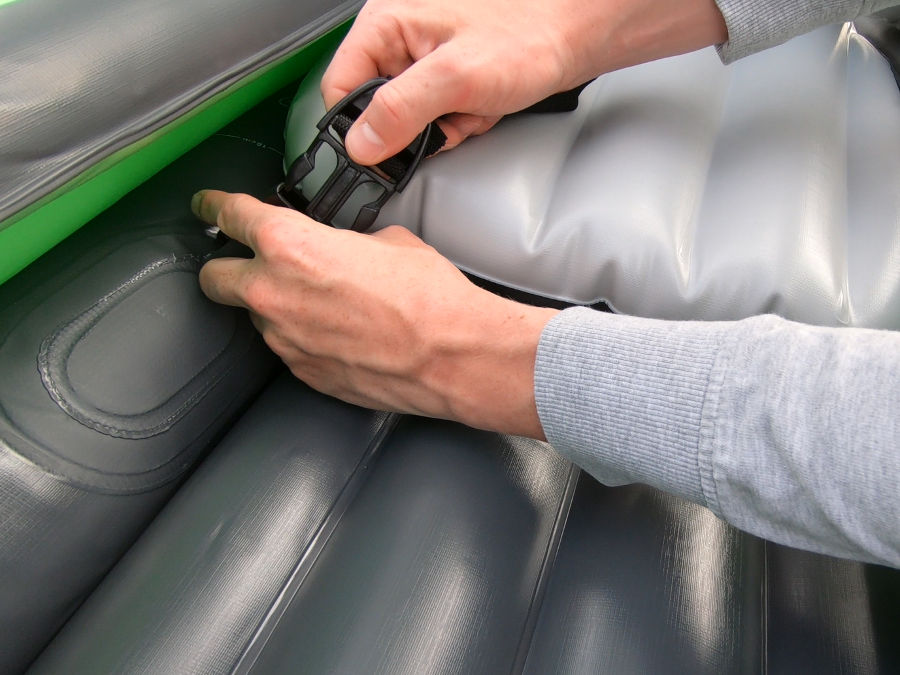
Finally, the footrest is inflated and placed in the bow of the boat and the skeg is attached. We consider the skeg in particular to be a very important feature. A skeg provides a much better directional stability, especially for inflatable kayaks.
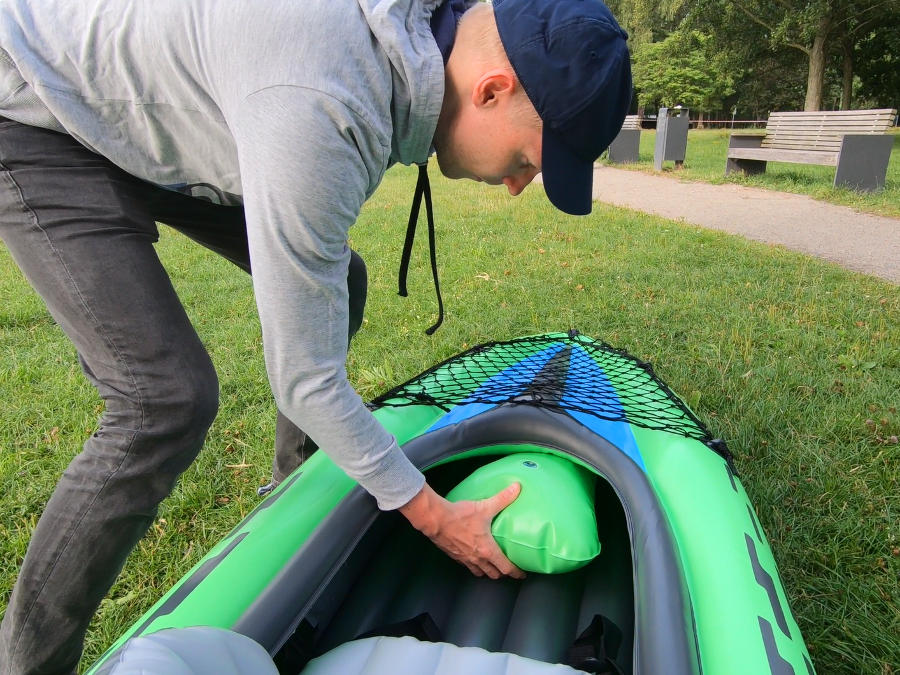
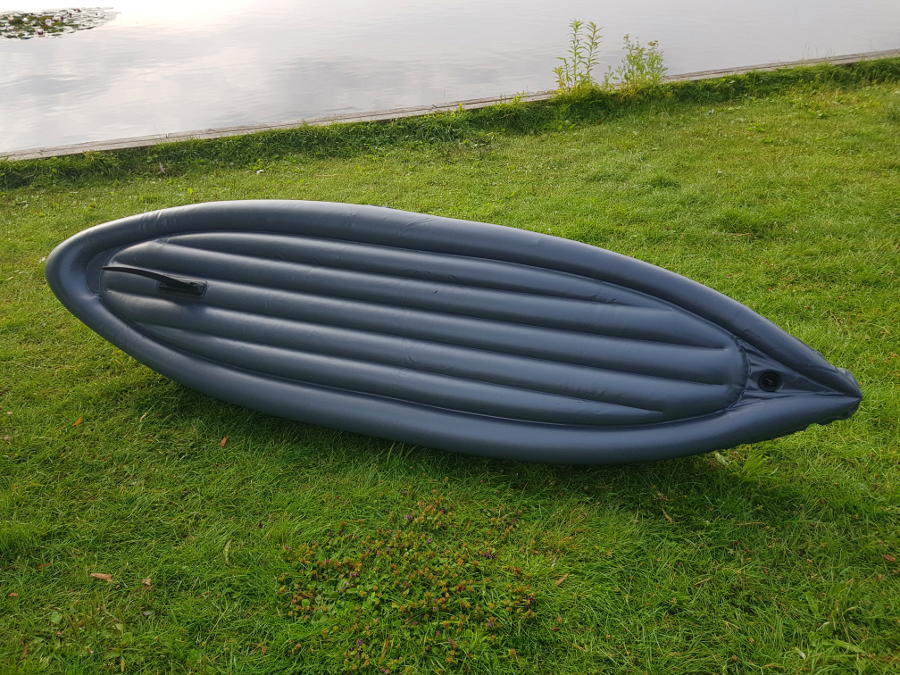
The boat was completely assembled in 8 minutes. We have to admit that we had built up the Intex Challenger K2 before and therefore we are a bit familiar with the construction. Nevertheless we think that a setup of 10 to 15 minutes is possible without any problems.
With exact investigation of the boat, we notice immediately that the firmness of the tubes can’t really compete with high-quality inflatable kayaks. This was not to be expected otherwise, as the kayak has an operating pressure of only 0.069 bar. Higher quality inflatable kayaks have a much higher air pressure (e.g. Advanced Elements AdvancedFrame). However, one cannot expect a higher operating pressure for the price. On the one hand, the air chambers would then have to be processed to a higher quality so that they can withstand a higher operating pressure. On the other hand, a higher air pressure in combination with the boat material wouldn’t be any good. In contrast, the low pressure prevents more or less this material more effective from any ground and stone contact because the thin skin can easier yield.
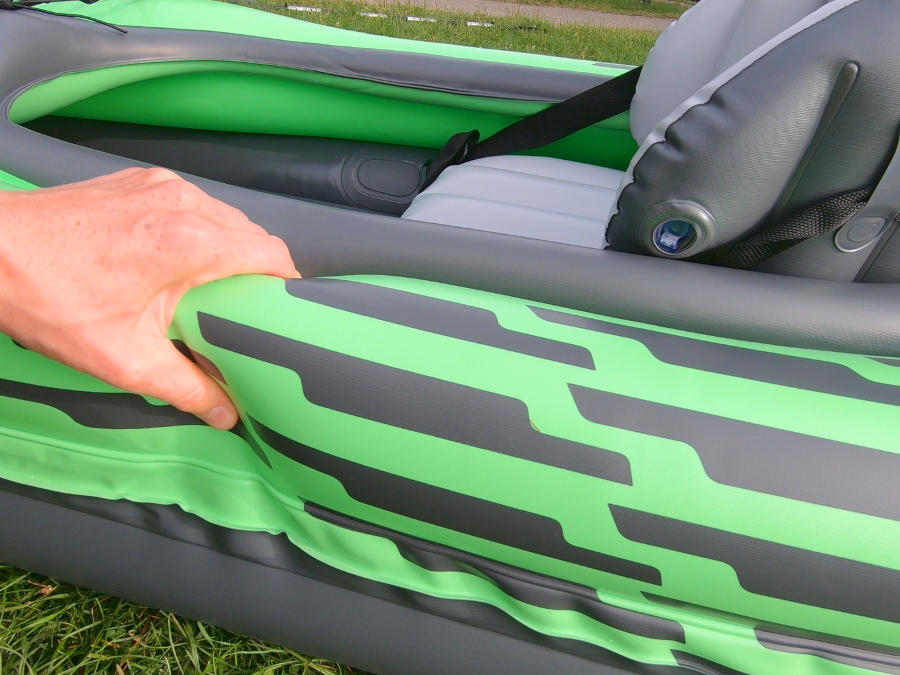
Besides the possibility to stow the luggage behind the seat in the stern, the kayak also has a luggage net on the bow. This gives a lot of space for additional luggage, which should be quickly at hand (e.g. shoes, water bottle, lunch box or dry bag). Behind the seat there is not too much space and of course it is also difficult to reach even while paddling. Therefore we like the large luggage net on the bow even more.
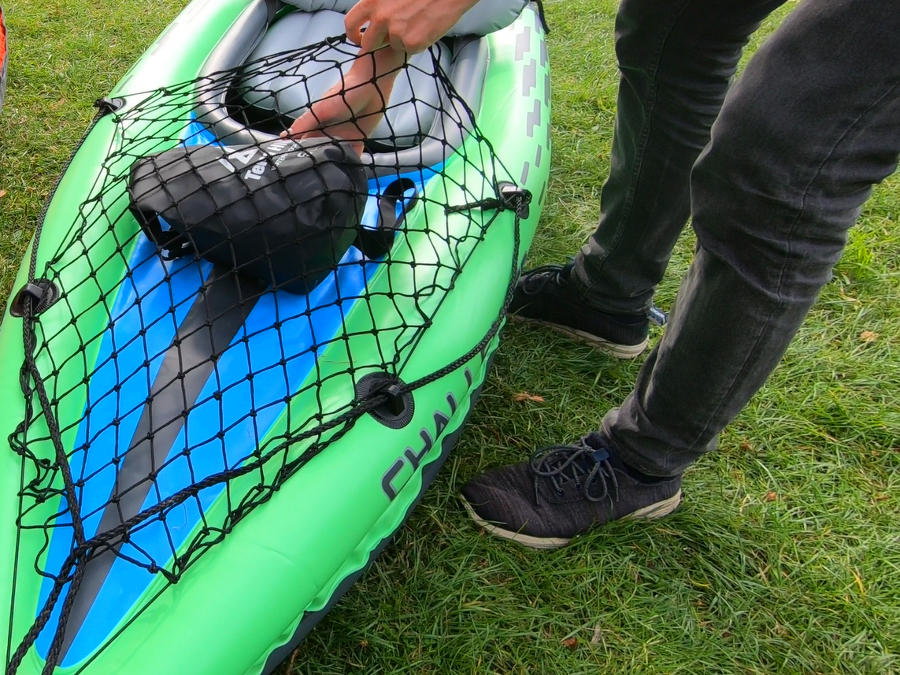
Review of the Intex Challenger K1 on the water
The air kayak has no handles. These are also not necessary. The boat is handy and light enough to be carried to the water. The canopy makes it a little more difficult to get in. However, the boat is stable in the water, so that capsizing is difficult.
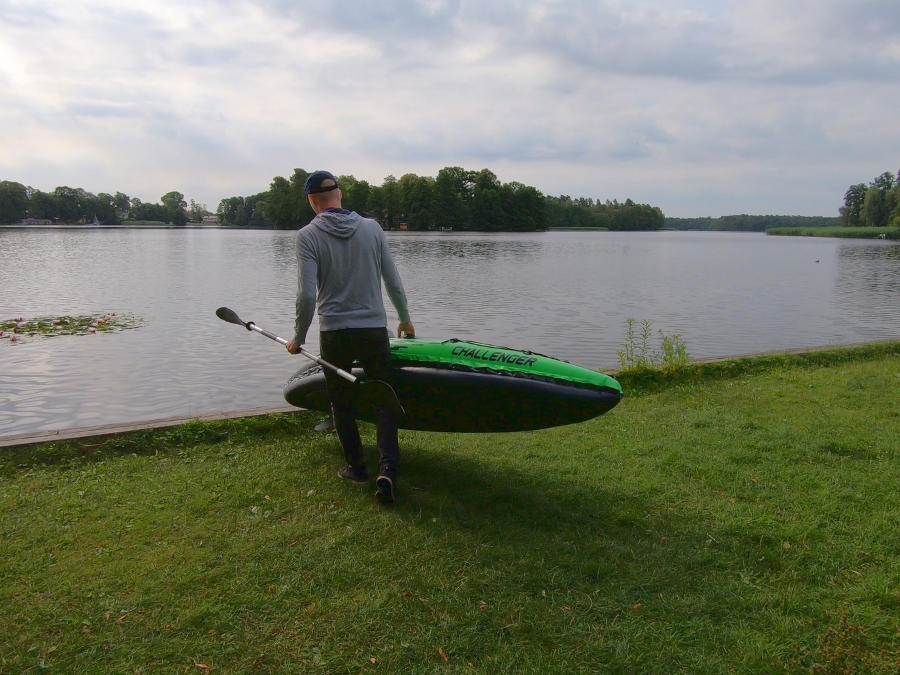

The inflatable kayak is constructed so that the stern and bow are somewhat closed. This considerably reduces the ingress of spray water. But this has a disadvantage for tall people. In my case the Intex Challenger K1 is too small, because I am too tall for the boat (6’2”). In addition the canopy is very low dimensioned, so that one feels constricted. You should be at least smaller than 5’9”. Otherwise we recommend the Intex Challenger K2, which can also be paddled as a solo kayak.
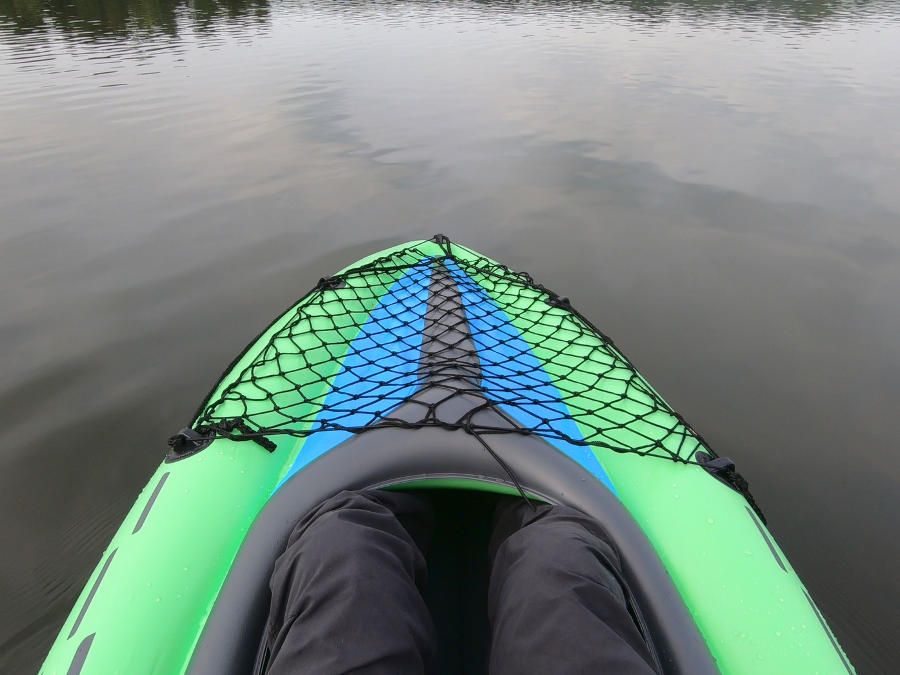
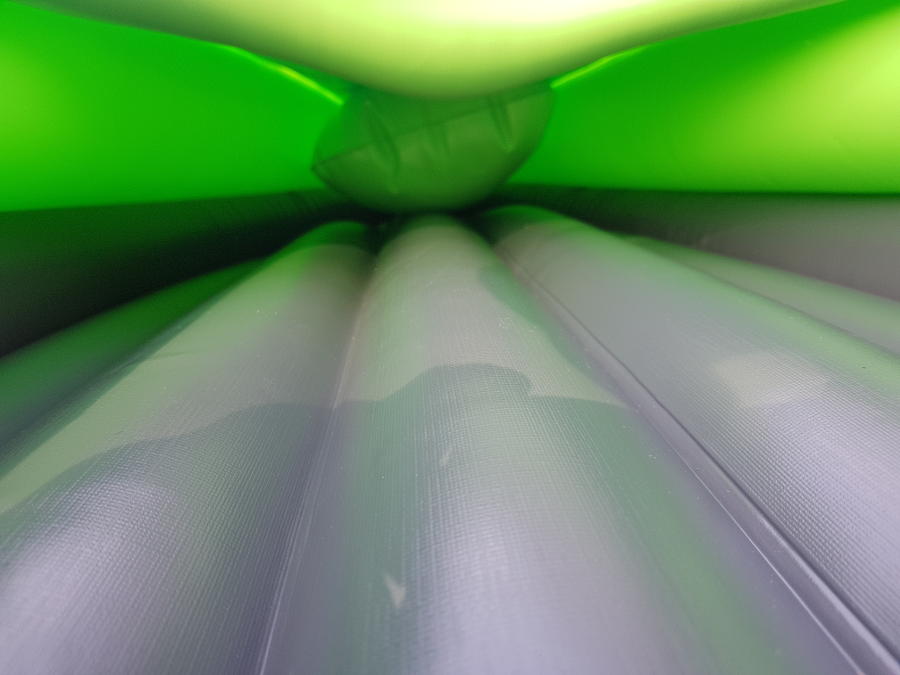
The directional stabilityand manoeuvrability are acceptable. For such a short boat we also expect it to react quickly to changes of direction. The skeg is definitely a must-have for the kayak because it improved the performance on the water a lot. However, it can’t compete with other inflatable ones in terms of performance, for example the Advanved Elements AdvancedFrame.
Those who have no comparison with other kayaks will find the speed to be sufficient and pleasant. The Intex Challenger K1 is perfectly adequate for leisurely explorations on a calm lake. However, if you want to join other kayakers on a kayak trip and they are paddling high quality inflatable kayaks or even fixed hull kayaks, you will not have any fun with Challenger K1. Because the inflatable kayak is too slow for that.
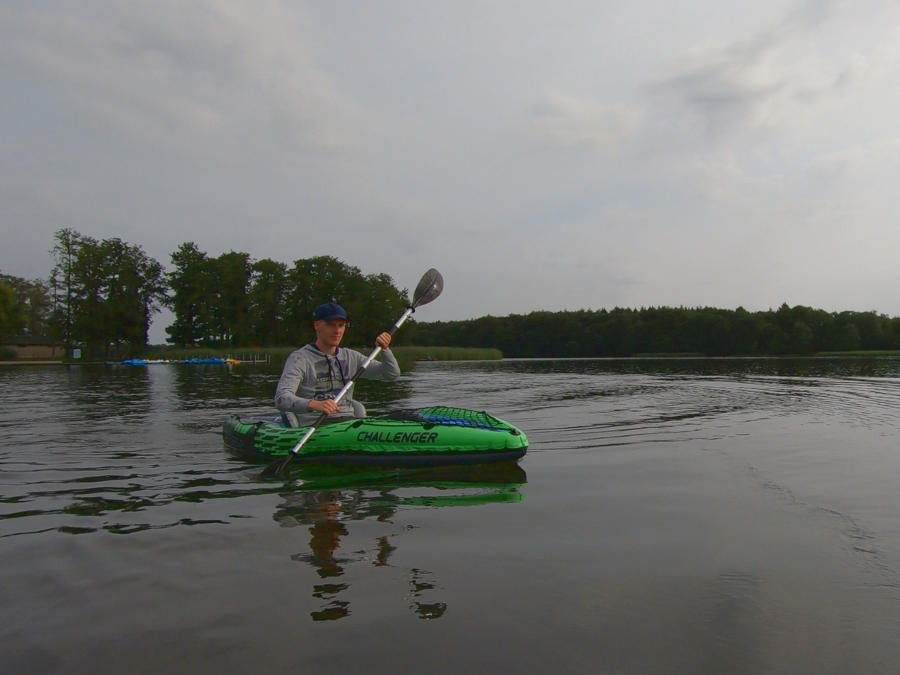
We had tested the Intex Challenger K1 on a calm little lake. The conditions were ideal. That’s what the Challenger K1 is designed for. For long tours on big lakes or fast flowing rivers with possible ground contact we do not recommend the boat. The boat has too little material thickness and too little air pressure for such purposes.
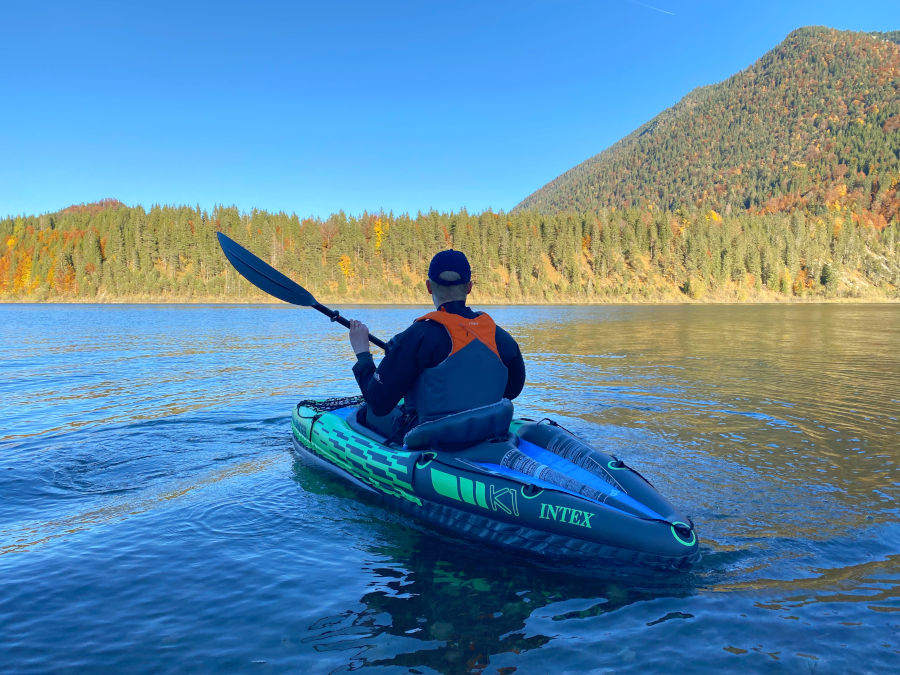
Dismantling
The dismantling was quick and easy. Only the rest of the air has to be pressed out a little bit while folding up or taking care that there are no sharp objects on the floor that could damage it. Once the air is completely out, the boat and all its accessories will fit without any problems into the carrying bag.

Strengths and Weaknesses
The biggest strength of the Challenger K1 is above all the very reasonable price with complete accessories. The biggest disadvantage for tall people is the small and narrow interior. So paddling is hardly possible or very uncomfortable. Also the material and the driving characteristics speak more for a boat to have fun on the water during ideal conditions on small lakes than a real inflatable kayak.
Advantages
+ very cheap + all accessories already included (except life vest) + very practical luggage net on bow + integrated deck + attractive design
Disadvantages
– small and cramped interior – slow on water – thin material – low operating pressure – more fun boat than inflatable kayak – wobbly double paddles – short warranty period of 90 days (from day of purchase)
Conclusion on the Intex Challanger K1
For those who want to try paddling for themselves first, the Intex Challenger K1 is ideal. The inflatable kayak is the only 1-person kayak for beginners on the market. It is particularly suitable for small paddling trips on calm waters. The boat is offered in a complete set with very useful accessories, such as the skeg, and enables an immediate start into paddling pleasure.
You should not compare the Challenger K1 with a fixed hull kayak, not even with a higher quality inflatable kayak. If you’re already sure you want to make several paddling trips in the season or don’t want to restrict yourself to calm waters, you should buy a higher quality boat. The purchase price is higher, but the differences in terms of handling characteristics and quality are enormous.
Accessories for the Intex Challenger K1
The scope of delivery of the boat includes the following accessories:
- Kayak paddle
- Inflatable foot brace
- Air pump
- Fin
- Repair patches
- Transport bag
In addition, we recommend the following accessories:
- Life jacket: Itiwit BA 50N+ * (good life jacket for beginners, very good price-performance ratio, more details in our test report).
- Dry Bag: Itiwit dry bag 10L* (ideal for protecting items from splashing water and short immersion in water, good workmanship, with carrying strap, available in different colors and sizes)
- Transport backpack: only a bag is included, which is intended for storage and short transport of the kayak to the water. If you want to transport the kayak longer distances and more comfortably to the water, we recommend the Itiwit transport backpack*, which is comfortable to carry and has enough space for the kayak and accessories.
Alternatives to the Intex Challenger K1
Intex has other inflatable kayaks, which could be interesting if you are looking for an entry-level inflatable. But same here, the kayaks are designed for short tours on calm water. There are no big differences between the Challenger K1 and K2. The Intex Challenger K2 is a tandem kayak and can also be paddle as a solo kayak. You are a bit faster with it since it’s longer. The Intex Explorer K2 looks quite different but it’s quite similar with the K2. We have compared both kayaks and you can find out the differences in our Intex Challenger vs. Explorer article.
The Intex Excursion Pro is more solid and the material of the boat skin is thicker. However, it’s also the most expensive Intex kayak.
